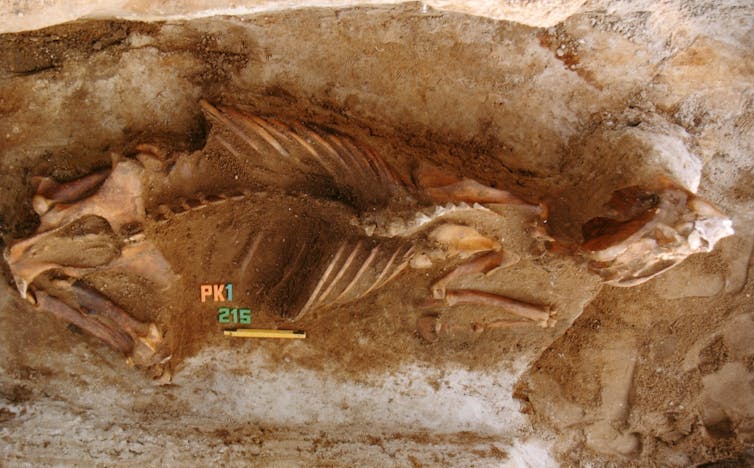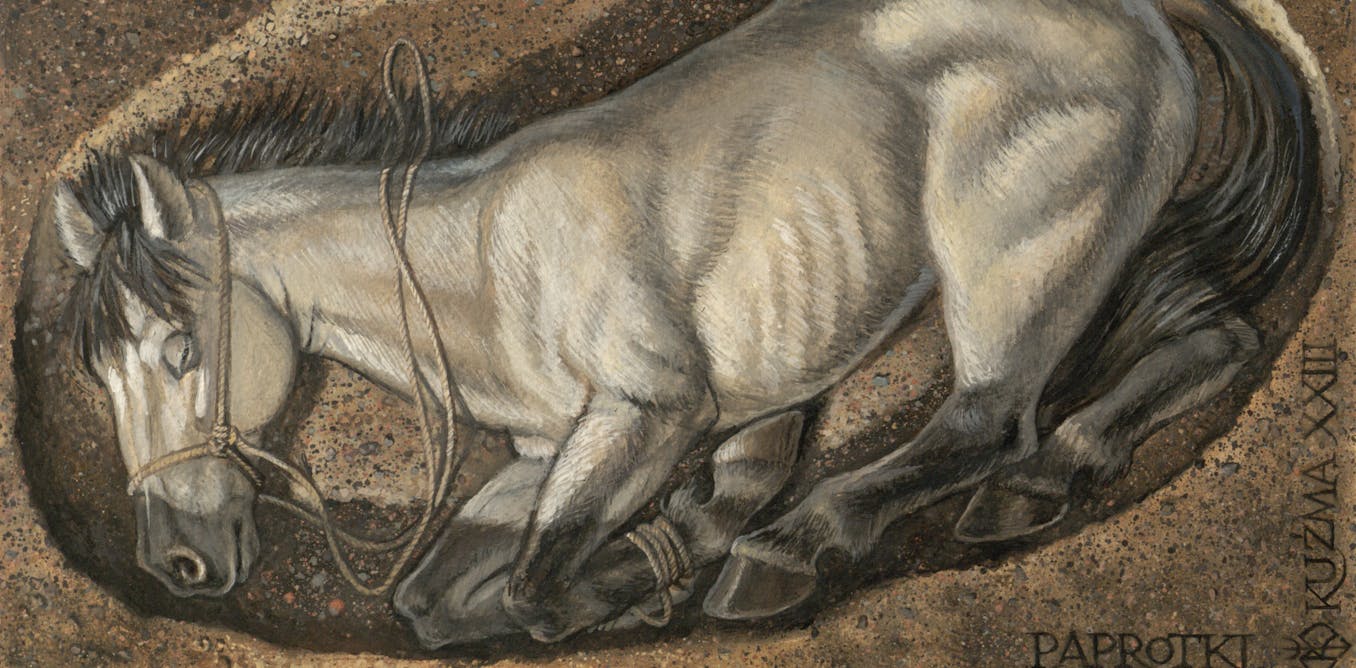Prehistoric communities from Iceland to the Eurasian Steppe sacrificed horses as part of their funeral rites. These Baltic tribes, known as the Balts, sacrificed horses longer than anywhere else in Europe, up until the 14th century. Christians despised this practice, however, and it quickly fell out of favour once a community converted to Christianity.
Archaeologists have studied Baltic sacrificial deposits for nearly 200 years. Two characteristics had seemed settled – that stallions were exclusively sacrificed, and that the Balts sourced their horses from the local tarpan horse population, commonly known as “forest” or “wild” horses.
However, our team’s latest research challenges these “facts” about the last horse sacrifices in Europe. It shows that about a third of sacrificial horses were, in fact, mares – and surprisingly, that some horses began their life in Christian Scandinavia and ended up across the Baltic Sea as sacrificial victims.
The Balts were a loose group of tribes that spoke a language related to modern Lithuanian and Latvian. The Romans called them Aestii, and traded with them for amber. The Balts were illiterate, but we have snippets written about them by outsiders such as the travellers and traders Wulfstan of Hedeby and Ohthere of Hålogaland.
The Balts were proficient horse riders who used equipment like bridles, saddles and stirrups. The 11th-century German historian Adam of Bremen wrote that Balt elites drank fermented mare’s milk and ate horse flesh.
The horse sacrifices were always public rituals that involved the whole community. Offering pits may have included multiple or single complete horses or partial animals, with or without their riding equipment. While the horses were commonly put in a crouched position or laid down on one side, in one noteworthy case in what is now northern Poland, a horse was buried standing upright. We also know from archaeological analysis that some were buried alive with their legs tied, or covered with heavy stones to stop them bucking out of the offering pit.
The deposition of partial animals would have been a particularly bloody, macabre public spectacle, involving decapitation, flaying, and halving or quartering of horses. While horses were often buried separately from humans, some were buried underneath a spread of cremated human bone and ash.
Mirosław Kuzma, Author provided (no reuse)
Why horses, though?
It’s important to note that other animals weren’t spared when it came to Baltic sacrifices. We have bone fragments from cows, sheep and goats, dogs, birds, fish and even a domesticated cat excavated from these tribal cemeteries.
But horse sacrifices were the most common and seemingly the most important, probably due to their spiritual, social and economic significance to the Balts.
Medieval travellers who visited these people wrote that horses were an important part of funeral ceremonies for elite members of society. In the late ninth century, Wulfstan detailed elaborate, daylong horse races in which the winners received the deceased’s property. The 14th-century chronicler Peter von Dusburg described horses being run to the point of no longer being able to stand and dying.
To learn more about why specific horses were chosen to be sacrificed, we sampled teeth from 80 horses buried in eastern Baltic cemeteries from around AD100 to 1300 for strontium isotope and genetic analysis. Strontium isotope analysis can tell us whether horses were raised in the same general area as where they were buried, because the adage “you are what you eat” is true on a molecular level.
The chemical element strontium varies from place to place based on local geology, and plants incorporate soil strontium. When horses eat plants, that strontium is incorporated into their bones and teeth.
Tooth enamel mineralises just once while teeth develop, and does not change. So, by measuring strontium isotope ratios in teeth and comparing them with the burial environment, archaeologists can tell if horses were raised locally or brought from elsewhere.
For genetic sex determination, horses are just like humans. Males have an X and Y chromosome, whereas females have two X chromosomes. Polymerase chain reaction (PCR) analysis tests which sex chromosomes are present in each sample.
Our strontium results show that at least three of the horses were from central Sweden or Finland – probably brought in by boat across the Baltic Sea from up to 1,000 miles (1500km) away. All date from the 11th to the 13th centuries, which means this increase in mobility began in the latter part of the Viking age and continued after.

Maciej Karczewski, Author provided (no reuse)
Our second major finding was that genetics confirmed up to a third of the horses sacrificed across all periods were mares, contrary to the previously accepted wisdom that only stallions were sacrificed.
People were well connected during and after the Viking age. Trade between neighbours continued, regardless of religion. One of the imported horses was even buried with a trader’s weight. Scholars always knew that material goods and slaves were transported along vibrant, far-reaching Viking trade routes. Our findings confirm that horses were as well.
While the exact meaning of these rituals remains mysterious, the sex of the horse wasn’t central to the rite nor the reason a horse was chosen. More likely, the determining factor was the high prestige value of an imported animal.
Nonetheless, the fact that these horses were brought from Christian lands and sacrificed in an ostentatiously pagan fashion may represent a powerful act of resistance and resilience by the Balts.



